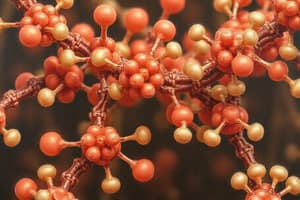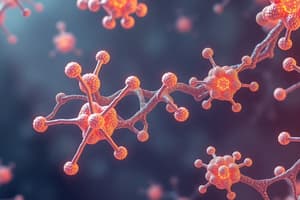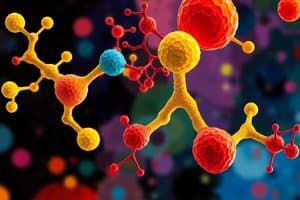Podcast
Questions and Answers
What are macromolecules primarily composed of?
What are macromolecules primarily composed of?
- Fatty acids
- Inorganic compounds
- Water-soluble organic molecules (correct)
- Vitamins
Which of the following is NOT a type of macromolecule found in cells?
Which of the following is NOT a type of macromolecule found in cells?
- Minerals (correct)
- Enzymes
- Nucleic acids
- Proteins
What is the primary function of molecular self-assembly?
What is the primary function of molecular self-assembly?
- To spontaneously form complex structures from macromolecules (correct)
- To degrade macromolecules into monomers
- To synthesize new organic molecules
- To stabilize cellular membranes
Which type of self-assembly requires external assistance from molecular chaperones?
Which type of self-assembly requires external assistance from molecular chaperones?
What are the building blocks that polymerize to form macromolecules called?
What are the building blocks that polymerize to form macromolecules called?
What type of structure is formed when macromolecules assemble into larger organized aggregates?
What type of structure is formed when macromolecules assemble into larger organized aggregates?
What is a critical feature of the native conformation of proteins?
What is a critical feature of the native conformation of proteins?
Which of the following best describes macromolecules?
Which of the following best describes macromolecules?
What is the primary function of the phospholipid bilayer in cells?
What is the primary function of the phospholipid bilayer in cells?
Which type of molecules can easily pass through the cell membrane?
Which type of molecules can easily pass through the cell membrane?
What term describes the ability of the cell membrane to allow certain substances to enter or exit while blocking others?
What term describes the ability of the cell membrane to allow certain substances to enter or exit while blocking others?
Which type of membrane proteins extend across the bilayer and interact with both the internal and external environments of the cell?
Which type of membrane proteins extend across the bilayer and interact with both the internal and external environments of the cell?
Where are peripheral membrane proteins located?
Where are peripheral membrane proteins located?
What characteristic of hydrophilic molecules affects their ability to cross the cell membrane?
What characteristic of hydrophilic molecules affects their ability to cross the cell membrane?
What distinguishes integral membrane proteins from peripheral membrane proteins?
What distinguishes integral membrane proteins from peripheral membrane proteins?
What role do membrane proteins play in relation to substances entering or exiting the cell?
What role do membrane proteins play in relation to substances entering or exiting the cell?
What topic is covered during Week 3 of the course?
What topic is covered during Week 3 of the course?
During which week is the mid-term test scheduled?
During which week is the mid-term test scheduled?
Which topic is introduced in Week 10 of the course?
Which topic is introduced in Week 10 of the course?
What is the primary focus of Week 12's topic?
What is the primary focus of Week 12's topic?
Which seminar session is scheduled for early Friday mornings?
Which seminar session is scheduled for early Friday mornings?
What aspect of cell biology is discussed in Week 4?
What aspect of cell biology is discussed in Week 4?
What significant event occurs during Week 14?
What significant event occurs during Week 14?
Which topic concerning genetics is included in Week 11?
Which topic concerning genetics is included in Week 11?
What is covered during Week 1 of the course?
What is covered during Week 1 of the course?
What is the main focus of Week 8's lecture?
What is the main focus of Week 8's lecture?
What percentage of the total assessment is attributed to the final examination?
What percentage of the total assessment is attributed to the final examination?
Who first observed cell division during the formation of pollens?
Who first observed cell division during the formation of pollens?
How many assignments are listed in the assessment structure?
How many assignments are listed in the assessment structure?
Which function is NOT attributed to cells?
Which function is NOT attributed to cells?
What is the role of specialized cells once they develop?
What is the role of specialized cells once they develop?
What is the total weight of the project in the overall assessment?
What is the total weight of the project in the overall assessment?
What is a common characteristic of all cells?
What is a common characteristic of all cells?
Which of the following describes unicellular organisms?
Which of the following describes unicellular organisms?
When is the mid-term test scheduled?
When is the mid-term test scheduled?
Which of the following is NOT a function of cells?
Which of the following is NOT a function of cells?
What is the primary reason why water is considered the universal solvent in biological systems?
What is the primary reason why water is considered the universal solvent in biological systems?
What percentage of a cell's weight is typically attributed to water?
What percentage of a cell's weight is typically attributed to water?
What is the shape of a water molecule in terms of its atomic arrangement?
What is the shape of a water molecule in terms of its atomic arrangement?
What type of bond forms between water molecules due to their polar nature?
What type of bond forms between water molecules due to their polar nature?
Why does water have a high surface tension?
Why does water have a high surface tension?
What is adhesion in the context of water molecules?
What is adhesion in the context of water molecules?
Which type of molecules readily dissolve in water?
Which type of molecules readily dissolve in water?
What distinguishes hydrophobic substances from hydrophilic substances?
What distinguishes hydrophobic substances from hydrophilic substances?
What does the term 'half-life' refer to in the context of hydrogen bonds in water?
What does the term 'half-life' refer to in the context of hydrogen bonds in water?
What contributes to the polarity of the water molecule?
What contributes to the polarity of the water molecule?
Which characteristic of water allows some insects to walk on its surface?
Which characteristic of water allows some insects to walk on its surface?
What happens to NaCl when it dissolves in water?
What happens to NaCl when it dissolves in water?
What is the typical bond angle between the hydrogen atoms in a water molecule?
What is the typical bond angle between the hydrogen atoms in a water molecule?
What is the significance of the tetravalent nature of the carbon atom in organic chemistry?
What is the significance of the tetravalent nature of the carbon atom in organic chemistry?
How does the bond energy of carbon-carbon (C−C) bonds compare to other carbon-containing bonds?
How does the bond energy of carbon-carbon (C−C) bonds compare to other carbon-containing bonds?
Explain the role of functional groups in carbon-containing molecules.
Explain the role of functional groups in carbon-containing molecules.
Why is carbon often referred to as the backbone of biological molecules?
Why is carbon often referred to as the backbone of biological molecules?
What is the octet rule and how does it relate to the stability of carbon compounds?
What is the octet rule and how does it relate to the stability of carbon compounds?
What are the two types of molecular self-assembly and how do they differ?
What are the two types of molecular self-assembly and how do they differ?
Explain the role of monomers in the synthesis of macromolecules.
Explain the role of monomers in the synthesis of macromolecules.
What is the significance of the native conformation of proteins?
What is the significance of the native conformation of proteins?
Why are macromolecules essential to cellular structures?
Why are macromolecules essential to cellular structures?
How do supramolecular structures contribute to cellular organization?
How do supramolecular structures contribute to cellular organization?
What is the size range of bacterial cells in micrometers?
What is the size range of bacterial cells in micrometers?
What is the primary role of cells in living organisms?
What is the primary role of cells in living organisms?
What significant contribution did Robert Hooke make to cell biology in 1665?
What significant contribution did Robert Hooke make to cell biology in 1665?
Describe one key difference between multicellular and unicellular organisms.
Describe one key difference between multicellular and unicellular organisms.
Why are most cells invisible to the naked eye?
Why are most cells invisible to the naked eye?
What role does water play in cell biology?
What role does water play in cell biology?
How do specialized cells respond to environmental changes?
How do specialized cells respond to environmental changes?
What process allows cells to grow and reproduce?
What process allows cells to grow and reproduce?
How does the size of animal and plant cells compare to bacterial cells?
How does the size of animal and plant cells compare to bacterial cells?
What is polymerization in the context of cell biology?
What is polymerization in the context of cell biology?
Who first observed cell division and in what context?
Who first observed cell division and in what context?
What is one critical function of cells related to metabolism?
What is one critical function of cells related to metabolism?
What is the significance of carbon in cellular structures?
What is the significance of carbon in cellular structures?
In what way do cells transport substances across their membranes?
In what way do cells transport substances across their membranes?
How do selectively permeable membranes benefit cells?
How do selectively permeable membranes benefit cells?
What does the term 'cells' mean in Latin, and how is it relevant to cell biology?
What does the term 'cells' mean in Latin, and how is it relevant to cell biology?
What aspect of cellular chemistry does self-assembly refer to?
What aspect of cellular chemistry does self-assembly refer to?
Flashcards
Monomer
Monomer
A small organic molecule that can be linked to other monomers to form a polymer.
Polymer
Polymer
A large molecule made up of repeating subunits called monomers.
Macromolecule
Macromolecule
A large biological molecule, typically formed by polymerization of smaller monomers.
Supramolecular Structure
Supramolecular Structure
Signup and view all the flashcards
Self-Assembly
Self-Assembly
Signup and view all the flashcards
Strict Self-Assembly
Strict Self-Assembly
Signup and view all the flashcards
Assisted Self-Assembly
Assisted Self-Assembly
Signup and view all the flashcards
Carbon's Role
Carbon's Role
Signup and view all the flashcards
Covalent Bond
Covalent Bond
Signup and view all the flashcards
Bond Energy
Bond Energy
Signup and view all the flashcards
Hydrocarbon
Hydrocarbon
Signup and view all the flashcards
Functional Group
Functional Group
Signup and view all the flashcards
Water's Polarity
Water's Polarity
Signup and view all the flashcards
Hydrogen Bond
Hydrogen Bond
Signup and view all the flashcards
Water's Cohesion
Water's Cohesion
Signup and view all the flashcards
Water's Surface Tension
Water's Surface Tension
Signup and view all the flashcards
Water as Solvent
Water as Solvent
Signup and view all the flashcards
Hydrophilic
Hydrophilic
Signup and view all the flashcards
Hydrophobic
Hydrophobic
Signup and view all the flashcards
Amphipathic
Amphipathic
Signup and view all the flashcards
Polymerization
Polymerization
Signup and view all the flashcards
Protein
Protein
Signup and view all the flashcards
Nucleic acid
Nucleic acid
Signup and view all the flashcards
Polysaccharide
Polysaccharide
Signup and view all the flashcards
Lipid
Lipid
Signup and view all the flashcards
Study Notes
Cellular Hierarchy
- Most cellular structures are composed of small, water-soluble organic molecules.
- These small organic molecules, or monomers, polymerize to form macromolecules.
- These macromolecules can function independently or be assembled into supramolecular structures.
- Supramolecular structures are components of organelles and other subcellular structures, ultimately making up the cell itself.
Self-Assembly
- Molecular self-assembly is the spontaneous folding of macromolecules and their interaction to form more complex structures.
- This process is inherent in the polymers themselves, such as the native conformation of a protein.
- Two types of self-assembly exist:
- Strict self-assembly: Only the polypeptide sequence is required.
- Assisted self-assembly: Requires a specific molecular chaperone to ensure the correct conformation.
Carbon's Importance
- Carbon is the most crucial atom in biological molecules, forming the backbone of most compounds important to cell biology.
- Carbon forms four chemical bonds with other atoms, satisfying the octet rule by sharing electron pairs in covalent bonds.
- Life on Earth would not be possible without carbon, as it is the basis for millions of organic compounds.
Carbon Bonding and Stability
- The stability of organic molecules is expressed as bond energy, a measure of the energy required to break a bond.
- Bond energies are typically expressed in calories per mole (cal/mol).
- Covalent bonds are strong and require a significant amount of energy to break, which contributes to the stability of organic molecules.
Carbon-Containing Molecules
- The diversity of carbon-containing molecules is a result of the tetravalent nature of the carbon atom.
- Hydrocarbons, consisting of only carbon and hydrogen atoms, are relatively insoluble in water.
- Functional groups are specific arrangements of atoms that confer distinct chemical properties on the molecules they are attached to.
Water's Importance
- Water is the most abundant component of cells and organisms, playing a vital role as the universal solvent in biological systems.
- The polarity of water molecules, caused by the unequal distribution of electrons, is its most critical attribute.
- The bent shape of the water molecule, with its partial negative charge on the oxygen atom and partial positive charges on the hydrogen atoms, allows for hydrogen bonding.
Properties of Water
- Water molecules are highly cohesive due to the formation of hydrogen bonds between adjacent molecules.
- This cohesiveness accounts for water's high surface tension and its role as an excellent solvent.
- Water's adhesive properties allow it to move upwards through plant tissues and enable insects to move across water's surface.
Water as a Solvent
- Water's polarity allows it to effectively dissolve a wide range of solutes, making it an excellent solvent for biological systems.
- Hydrophilic molecules, with an affinity for water, dissolve readily, while hydrophobic molecules, lacking this affinity, do not.
- Some biological macromolecules have both hydrophilic and hydrophobic regions, making them amphipathic.
Polymerization of Small Molecules
- Most cellular structures are made of ordered arrays of linear polymers called macromolecules.
- Important macromolecules in the cell include proteins, nucleic acids (DNA and RNA), polysaccharides, and lipids.
- These macromolecules are synthesized by the polymerization of small molecules.
- This process involves joining monomers together, forming a chain-like structure.
Studying That Suits You
Use AI to generate personalized quizzes and flashcards to suit your learning preferences.



